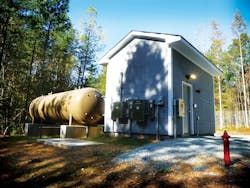Rougemont Critical Water Infrastructure
Cost: $2.9 million
Location: Rougemont, N.C.
Year: 2016-12-12
Size: 25,200 gpd
Owner: Durham County
Designers: WithersRavenel
Contractor: H. G. Reynolds Co. Inc.
The Flint, Mich., crisis may have brought tap water contamination to the forefront of the nation’s consciousness, but such issues are all too familiar to some residents of Rougemont, N.C. (population: fewer than 1,000), who have been coping with the effects of contaminated drinking water for more than 25 years.
In the 1980s and 1990s, Rougemont discovered that fuel tanks from nearby gas stations had leached petroleum-based hydrocarbons into the area’s bedrock, contaminating local wells. Since then, the state of North Carolina has supplied Rougemont residents with bottled drinking water, but until recently they still bathed, washed dishes and watered their lawns using the contaminated groundwater.
Concerned for their well-being, Rougemont residents contacted Durham County, which collaborated with the North Carolina Department of Environmental Quality (NCDEQ) to find a solution to the contamination issue. At first, Durham County and NCDEQ considered extending the water systems of the nearby cities of Roxboro and Durham, but abandoned the idea due to cost. They settled on creating a small, independent water system to supply the town. In the spring of 2015, the Durham board of county commissioners authorized Durham County staff to issue a request for proposal for the distribution line.
The project involved constructing two drinking water wells, a well house and a distribution system to deliver clean drinking water to Rougemont residents. Residents also had the option to close their private wells, as a means of preventing potential contamination issues in the future.
Before construction could begin, Durham County and NCDEQ faced the problem of finding funding—particularly difficult in light of the fact that only 40 Rougemont households were affected by the contamination. Funding for the $2.9 million project eventually came from a Community Block Development Grant (CBDG) for $600,000; NCDEQ funds for $520,000; a federal grant for $250,000; and Durham County capital funds for $1,516,887. Small Cities CDBGs are funded through the U.S. Department of Housing and Urban Development; this grant was provided through the North Carolina Department of Commerce Div. of Community Assistance.
Thanks to the CBDGs, residents living within 250 ft of contaminants with levels above state-defined thresholds for safe consumption were offered a connection to the system at no cost. Due to extra funding from NCDEQ, the federal grant and Durham County, capital recovery charges were not assessed to Rougemont residents.
Equipment used in the project included a submersible pump, a hydro-pneumatic tank, high-performance turbine meters, metering pumps, a remote pump monitoring and control system, and a custom motor control panel.
The Rougemont Critical Water Infrastructure Improvements project now is up and running, its ribbon-
cutting having taken place on Sept. 22.
“The county is thrilled to bring to a close not only a six-year county project in northern Durham County, but to bring to a positive conclusion a decades-old public health problem in Rougemont,” said Drew Cummings, chief of staff for Durham County. “The health of our county residents is a paramount concern for us, and we hope this new water system can also play a role in revitalizing the broader community in Rougemont. We are truly grateful for the financial contributions of the state and the [U.S. Environmental Protection Agency] to this project and also commend persistent citizens who helped this project come to fruition.”
Project Year: 2016-12-12Contractor: H. G. Reynolds Co. Inc.Designers: WithersRavenelOwner: Durham CountyLocation: Rougemont, N.C.Cost: $2.9 millionSize: 25,200 gpd